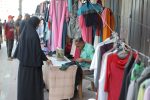GAZA, (PIC)
Student Osama Badr was looking forward to taking his high school exams this year, joining university, and becoming a software engineer. However, his dream is gradually fading away with the continuation of the horrifying Israeli war on the Gaza Strip, which has now entered its fourth month.
Like most students in the Gaza Strip, Osama Badr and his family were forcibly displaced from the northern part of the Strip to the south in Rafah, where they reside in a school that has been turned into an overcrowded shelter for thousands of displaced Palestinians.
Aspirations and dreams
The Israeli war on Gaza, described by the United Nations as the bloodiest and most intense in the twenty-first century, has undermined the academic year, destroying most of the schools in the enclave and transforming the remaining schools into shelters.
The Ministry of Education and Higher Education in Ramallah documented the martyrdom of 4,327 students and the injury of 7,819 others, as well as the martyrdom of 231 teachers and administrators and the injury of 756 others with various injuries in the Gaza Strip due to the Israeli aggression since October 7 until the end of last month (January).
Student Badr tells Sanad News Agency, “After 11 years of studying, working hard, and waiting for the moment of taking the high school exams and achieving an excellent result, and joining the university to fulfill my dream of becoming a software engineer, the war destroyed everything.”
The Palestinian student adds, “The occupation destroyed everything. It destroyed our future, our schools, our homes, our neighborhoods, our streets, and even my books and memories, which were crushed by Israeli tanks after they destroyed our house during their incursion into northern Gaza.”
He continues, “Everything was lost in a blink of an eye. Our peers, students in the West Bank, Arab countries, and around the world, are studying in schools and preparing for exams, while we sit in schools trembling from the cold and seeking shelter from Israeli shelling and killing.”
Prior to the outbreak of the war on October 7 last year, more than 625,000 male and female students went to schools in all governorates of the Gaza Strip in the new academic year 2023-2024.
The number of schools in Gaza reached 796 schools, including 442 government schools, 284 schools affiliated with UNRWA, and 70 private schools. The number of school buildings for the same academic year in the Strip reached 550, including 303 government school buildings, 182 school buildings affiliated with UNRWA, and 65 private school buildings.
Meanwhile, the number of higher education institutions in Gaza was 17, in addition to an open education university. Approximately 87,000 male and female students in the sector are enrolled in these institutions.
Frustration and disappointment
High school student Siraaj Al-Attar feels frustrated and disappointed in the miserable life she is living in one of the displaced persons’ tents in Rafah. She was forced to leave her home in northern Gaza with her family of nine to escape Israeli bombardment.
Al-Attar, with tears filling her eyes, says, “Before the start of the academic year, I was studying and preparing books and references, getting myself ready for the high school exams, but everything was lost in a blink of an eye.”
The Palestinian student, who was studying at Umm Al-Fahm School in Beit Lahia, had hoped to achieve a high grade that would allow her to enroll in medical school and fulfill her family’s dream of becoming a respected doctor.
Al-Attar explains that the war destroyed their psyche, their future, and their dreams. It wiped away her memories, books, and educational certificates after Israeli airstrikes destroyed her family’s home in Beit Lahia in northern Gaza.
According to the Palestinian Government Media Office, the Israeli war resulted in the complete destruction of 100 schools and universities and partial destruction of 295 schools and universities from October 7, 2023 until February 3, 2024.
However, high school student Tasneem Al-Kurdi from Gaza, residing in a school turned shelter in Rafah, has not given up. She spends her time memorizing the Quran and engaging in self-education whenever the circumstances allow.
Al-Kurdi tells Sanad News Agency, “I wished to take the high school exams this year, achieve an excellent grade, and study physical therapy to fulfill my father’s dream. But fate had its way.”
The Palestinian student adds that she utilized the ordeal of displacement to memorize parts of the Quran by joining a program at the school where she lives with her family.
Ceasefire needed
Approximately 90% of Gaza’s population, totaling 2.3 million people, have been forcibly displaced from their homes and find themselves in a situation that does not allow them to work or learn. They suffer from hunger, thirst, cold weather, frequent electricity outages, and intermittent internet connectivity.
Mohammed Isa, the planning department head at the Directorate of Education in Rafah, who oversees one of the schools turned shelters, says that any plans to resume the academic year are contingent upon an end to the fierce Israeli war on the Gaza Strip.
Isa tells Sanad News Agency, “The educational life has come to a near-complete halt since the beginning of the aggression. There are over 600,000 students who are not attending schools,” pointing out the severe damage to the educational process, as well as the psychological effects.
The Palestinian official also emphasized that Israel’s targeting of schools was part of a comprehensive targeting that affected both humans and stones.















